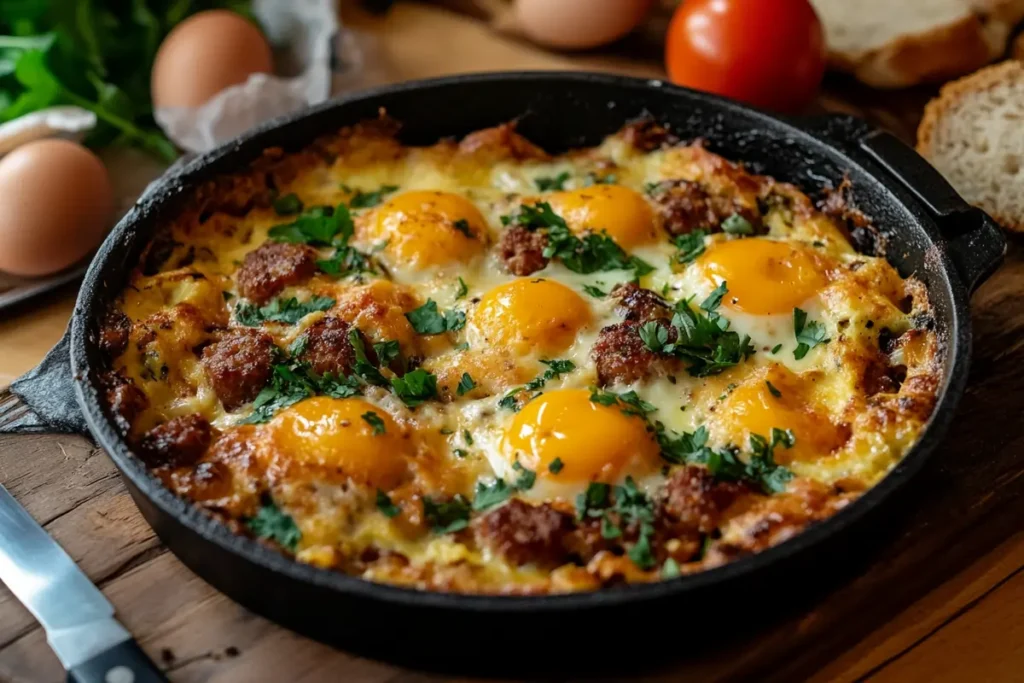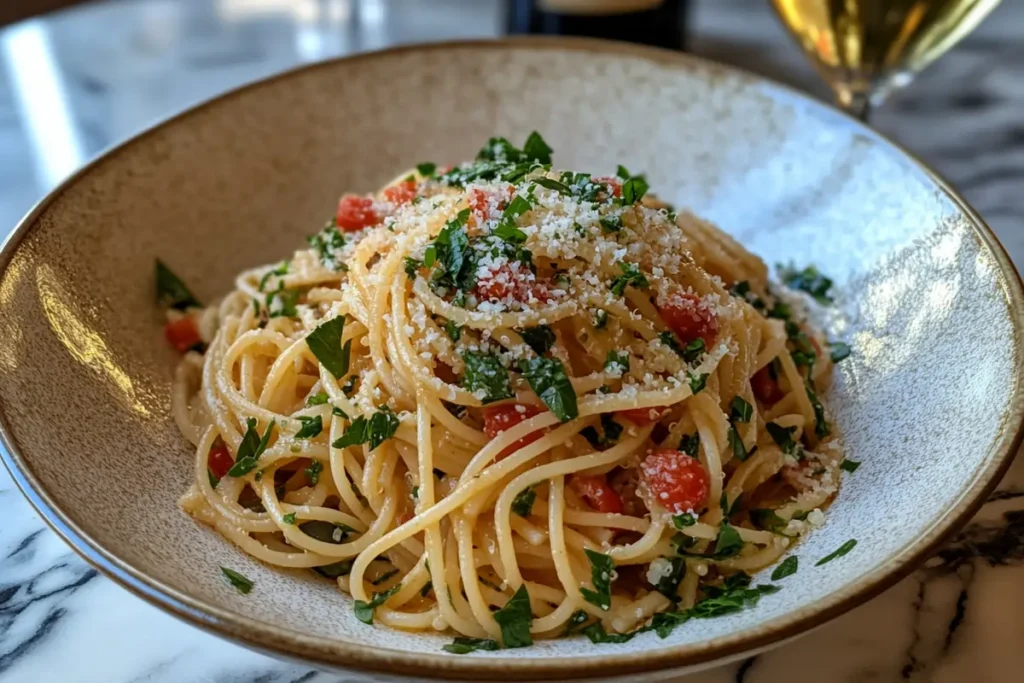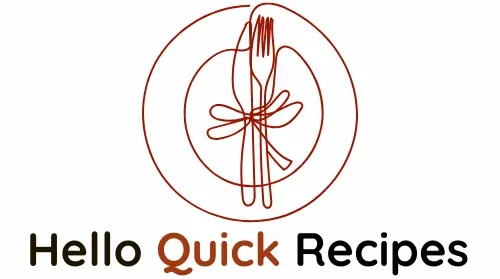Casseroles have long been a cornerstone of home-cooked meals, cherished for their simplicity, versatility, and comforting appeal. For instance, whether you’re a busy parent juggling work and family life, a college student seeking budget-friendly options, or someone simply looking for an efficient way to prepare hearty, delicious dishes, easy casserole recipes can truly be a lifesaver.
Table of Contents
The Importance of Easy Casserole Recipes
Easy casserole recipes are an ideal solution for those who want to prepare home-cooked meals without spending hours in the kitchen. In addition, with minimal prep and straightforward steps, these recipes make it possible to enjoy nourishing dishes with minimal effort. Moreover, they offer a creative way to repurpose ingredients you already have on hand, thus reducing food waste and saving money.
1. History of Casseroles
1. The Origin and Evolution of Easy Casserole Recipes
The word “casserole” comes from the French term for a deep dish or pan, but the concept of cooking combined ingredients in a single vessel dates back to ancient times. Early versions appeared in Greek and Roman cuisines, where layered, baked meals maximized flavor.
Modern casseroles emerged in 19th-century Europe and gained widespread popularity in 20th-century America, especially with the advent of canned soups in the 1930s. These ready-made ingredients revolutionized home cooking, making casseroles a convenient, staple dish.
2. The Popularity of Easy Casserole Recipes in Different Cultures
Casseroles have been embraced worldwide, each culture adding its flair. Italian lasagna, British shepherd’s pie, and Middle Eastern moussaka exemplify how diverse cuisines adapt the concept. In the U.S., dishes like green bean casserole and tater tot hotdish are iconic.
Their appeal lies in their simplicity, adaptability, and ability to bring people together over a shared, comforting meal. Casseroles remain a global favorite for their convenience and timeless charm.
2. Benefits of Easy Casserole Recipes
Casserole cooking offers numerous advantages that make it a favorite among home cooks.
1. Time-Saving Benefits of Easy Casserole Recipes
Casseroles simplify meal preparation by combining ingredients into a single dish, minimizing cooking time and reducing cleanup. Many recipes can be prepared ahead and easily reheated, perfect for busy schedules.
2. Nutritional Benefits of Easy Casserole Recipes
Casseroles provide an opportunity to include a balanced mix of proteins, vegetables, and grains in one meal. By incorporating wholesome ingredients, they can be tailored to meet various dietary needs while delivering a nutritious, satisfying dish.
3. Versatility Benefits of Easy Casserole Recipes
The flexibility of casseroles allows for endless creativity. From using pantry staples to accommodating leftovers, they can be adapted to suit different tastes, dietary preferences, and cultural influences, making them a practical and delicious meal option.
3. Essential Ingredients for Easy Casserole Recipes
Creating delicious and satisfying casseroles starts with choosing the right combination of ingredients. Whether you’re cooking for a family dinner or meal prepping for the week, these essential ingredients for easy casseroles ensure variety, flavor, and nutrition.
1. Proteins: Chicken, Beef, Tofu
Protein is a cornerstone of any casserole, providing flavor and sustenance. Chicken, whether shredded, diced, or ground, is a versatile option that pairs well with creamy or tomato-based sauces. Ground beef or beef chunks add richness to dishes like shepherd’s pie or lasagna. For plant-based alternatives, tofu is an excellent choice, absorbing flavors from sauces and spices while keeping the dish light and nutritious.
2. Vegetables: Broccoli, Spinach, Carrots
Vegetables bring color, texture, and nutrition to casseroles. Broccoli is a favorite for creamy, cheesy casseroles, while spinach adds a tender, nutrient-packed layer to dishes like lasagna. Carrots, whether diced or shredded, add a touch of sweetness and crunch, making them a great addition to hearty bakes.
3. Carbohydrates: Pasta, Rice, Potatoes
Carbohydrates form the backbone of many easy casseroles, providing substance and comfort. Pasta varieties like penne or macaroni work wonderfully in baked dishes with creamy or tomato-based sauces. Rice is ideal for layered casseroles, absorbing flavors as it cooks. Potatoes, whether mashed, sliced, or cubed, are a classic choice for their versatility and satisfying texture.
4. Sauces and Seasonings
Sauces and seasonings tie all the ingredients together, creating depth of flavor. Cream-based sauces, such as béchamel, are ideal for rich, indulgent casseroles, while tomato-based sauces bring brightness and tang. Seasonings like garlic, onion, herbs, and spices elevate the overall taste, ensuring every bite is flavorful and satisfying.
By combining these essential ingredients for easy casseroles, you can create endless variations that cater to your preferences and make mealtime enjoyable and stress-free.
4. Top 5 Easy Casserole Recipes
Casseroles are beloved for their simplicity, versatility, and ability to please a crowd. Here are five easy casserole recipes that you can whip up with minimal effort, perfect for any occasion.
Recipe 1: Classic Tuna Noodle Casserole
This timeless dish is a family favorite. Combine cooked egg noodles with canned tuna, a can of cream of mushroom soup, frozen peas, and shredded cheddar cheese. Top with breadcrumbs for a crispy finish and bake at 375°F (190°C) for 25–30 minutes. It’s a comforting meal that’s quick and budget-friendly.
Recipe 2: Cheesy Broccoli and Rice Casserole
This creamy, cheesy casserole is perfect for a side dish or a vegetarian main. Cook rice and mix it with steamed broccoli, cream of chicken soup (or a vegetarian alternative), shredded cheddar cheese, and a sprinkle of garlic powder. Bake at 350°F (175°C) for 30 minutes until bubbling and golden.
Recipe 3: Chicken and Mushroom Casserole
A hearty and satisfying meal, this dish features tender chicken and earthy mushrooms. Sauté chicken and mushrooms, then layer them with cooked egg noodles or rice. Add a creamy sauce made from sour cream and cream of mushroom soup, sprinkle with Parmesan cheese, and bake at 375°F (190°C) for 30 minutes.
Recipe 4: Vegetarian Black Bean Enchilada Casserole
This vibrant casserole is packed with flavor and perfect for Meatless Monday. Layer corn tortillas with black beans, enchilada sauce, diced tomatoes, corn, and shredded cheese. Repeat layers and top with extra cheese. Bake at 375°F (190°C) for 20–25 minutes, then garnish with fresh cilantro and serve with sour cream.
Recipe 5: Breakfast Sausage and Egg Casserole
Ideal for brunch or meal prep, this casserole combines breakfast staples in one dish. Mix cooked sausage, beaten eggs, milk, shredded cheese, and diced bread cubes. Pour into a greased baking dish and bake at 350°F (175°C) for 35–40 minutes until set. It’s hearty and flavorful!

These easy casserole recipes are quick to prepare, packed with flavor, and adaptable to suit your preferences. Whether you need a comforting dinner or a crowd-pleasing brunch dish, these casseroles have you covered.
5. Tips for Preparing Quick and Delicious Casseroles
Casseroles are the ultimate time-saving meals, and with a few clever strategies, you can ensure they’re both quick and delicious. Here are some essential tips for preparing quick and delicious casseroles, focusing on efficiency and flavor.
1. Meal Prepping Strategies
Meal prepping is key to assembling casseroles quickly. Start by chopping vegetables, cooking proteins, and preparing starches like pasta or rice ahead of time. Store these components in separate containers in the refrigerator, so they’re ready to mix and bake when needed. You can also pre-make sauces, such as béchamel or tomato-based varieties, and freeze them in portions. These preparations significantly cut down on cooking time and make weeknight dinners stress-free.
2. Utilizing Leftovers
Casseroles are a fantastic way to repurpose leftovers into new, flavorful dishes. Transform last night’s roasted chicken into a creamy chicken and rice casserole, or use extra cooked vegetables in a cheesy veggie bake. Leftover pasta or grains like quinoa can serve as the base for many casserole recipes. By creatively combining these ingredients, you minimize food waste and create meals that are both satisfying and economical.
3. Freezing and Reheating Techniques
One of the greatest advantages of casseroles is their freezer-friendly nature. To freeze a casserole, assemble it in a freezer-safe dish but skip the baking step. Store it in airtight plastic wrap and with aluminum foil to avoid freezer burn. Label it with the date and cooking instructions for easy reference.
To serve it, it is best to leave it in the refrigerator overnight to thaw. And cook as explained. For individual portions, divide the casserole into smaller containers before freezing. Reheat portions in the microwave or oven for a quick and delicious meal.
By following these tips for preparing quick and delicious casseroles, you can save time, reduce waste, and enjoy hearty, flavorful meals that fit seamlessly into your busy lifestyle.
6. Healthier Alternatives for Casserole Lovers
Casseroles are a comforting and versatile meal option, but they don’t have to be heavy or overly indulgent. By making a few thoughtful substitutions, you can enjoy healthier casseroles without sacrificing flavor. Here are some tips for healthier alternatives for casserole lovers.
1. Using Whole Grains
Swap refined grains like white rice or regular pasta with whole-grain options to increase the nutritional value of your casseroles. Whole-grain pasta, brown rice, quinoa, or farro add fiber and essential nutrients while providing a satisfying texture. These alternatives can seamlessly replace their refined counterparts in most recipes, making your casseroles heartier and more healthful.
2. Incorporating Lean Proteins
Lean proteins are a great way to reduce the calorie and fat content of casseroles while maintaining their filling and delicious qualities. Opt for chicken breast, turkey, or plant-based proteins like tofu, tempeh, or legumes instead of higher-fat meats like ground beef or pork. Fish, such as salmon or cod, can also be a nutritious addition to certain casseroles, offering healthy omega-3 fatty acids.
3. Reducing Sodium and Fat Content
Many traditional casserole recipes rely on canned soups and heavy sauces, which can be high in sodium and saturated fat. For healthier options, prepare your own sauces using low-sodium broth, plain Greek yogurt, or a homemade béchamel with olive oil instead of butter. Limit cheese to a light sprinkle for flavor, or use reduced-fat varieties. Enhance taste with herbs, spices, and fresh ingredients instead of relying on salt-heavy seasonings.
By incorporating these healthier alternatives, casserole lovers can enjoy their favorite dishes guilt-free, knowing they’re nourishing their bodies with wholesome and balanced meals.
7. Easy Casserole Recipes for Special Diets
Casseroles can easily be adapted for special diets while remaining delicious and satisfying.
1. Gluten-Free Options
Substitute traditional pasta or breadcrumbs with gluten-free alternatives like rice, quinoa, or gluten-free pasta. Thicken sauces with cornstarch, and opt for naturally gluten-free ingredients like sweet potatoes or chicken.

2. Vegetarian and Vegan Choices
Vegetarian casseroles shine with vegetables, grains, and plant-based proteins like lentils or tofu. For vegan options, use plant-based milk, vegan cheese, or cashew cream in recipes like black bean enchilada bakes or tofu-veggie casseroles.
3. Low-Carb Recipes
Swap high-carb staples with zucchini, cauliflower, or spaghetti squash. Try dishes like zucchini lasagna, cauliflower mac and cheese, or cheesy chicken and broccoli bakes for flavorful, low-carb meals.
These adaptations make casseroles a versatile option for any dietary preference.
8. International Casserole Inspirations
Casseroles are enjoyed worldwide, each culture adding its unique flavors and ingredients. Here are some international casserole inspirations to bring global flair to your meals.
1. French: Ratatouille
This vegetable-packed casserole combines zucchini, eggplant, tomatoes, and bell peppers in a rich tomato sauce, layered and baked to perfection. It’s a simple yet elegant dish bursting with Mediterranean flavors.
2. Italian: Lasagna
A classic Italian favorite, lasagna features layers of pasta, rich tomato sauce, creamy béchamel or ricotta, and cheese. It’s versatile, allowing for meat, vegetable, or vegan variations.
3. Mexican: Chilaquiles
This vibrant dish combines tortilla chips layered with salsa, beans, cheese, and optional protein like chicken or eggs. Baked until crispy and topped with fresh herbs, it’s a flavorful crowd-pleaser.
4. Greek: Moussaka
A hearty casserole of layered eggplant, ground lamb or beef, and béchamel sauce, moussaka is rich and satisfying, showcasing the bold flavors of Greek cuisine.
These international casseroles highlight the diversity and versatility of this beloved cooking style, bringing the world to your table.
9. Common Mistakes to Avoid When Making Casseroles
Overcooking ingredients is a frequent error that can lead to mushy textures and diminished flavors. Using a slow cooker, as suggested in Slow Cooker Creamy Chicken Pasta, can help maintain the perfect consistency for ingredients like chicken and vegetables.
Improper layering techniques can cause uneven cooking, with some parts overdone and others undercooked. To ensure even results, consider layering your casserole similar to techniques used in Crockpot Creamy Chicken Pasta, where careful layering creates balanced flavors.
Neglecting seasoning balance is another pitfall. Over-seasoning or under-seasoning can ruin an otherwise perfect dish. Drawing inspiration from flavorful options like Cajun Chicken and Shrimp Alfredo Pasta, experiment with bold spices while tasting along the way.
10. (FAQs) About Easy Casserole Recipes
1. What are some easy casserole recipes for beginners?
For beginners, recipes with minimal steps, like Crockpot Creamy Chicken Pasta with Cream Cheese, are ideal. These dishes are straightforward and deliver hearty, satisfying results.
2. How can I make my casseroles healthier?
You can make casseroles healthier by incorporating whole grains and lean proteins. Try adapting ideas from Slow Cooker Chicken Pasta No Cream, which uses lighter ingredients for a healthier version.
3. Can I prepare casseroles ahead of time?
Yes, casseroles are perfect for meal prepping. It can be prepared in advance, stored, and reheated when needed.
4. What are some vegetarian casserole options?
Vegetarian options abound, and you can create flavorful casseroles by combining vegetables and grains. While not strictly vegetarian, dishes like Cajun Shrimp Chicken Pasta can inspire veggie-filled adaptations.
5. How do I store and reheat leftover casseroles?
Store leftovers in airtight containers in the refrigerator and reheat in the oven or microwave. Recipes like Chicken Pasta Slow Cooker offer reheating tips to maintain taste and texture.
6. Can I freeze casseroles for later use?
Absolutely! Casseroles freeze well when prepared correctly.

